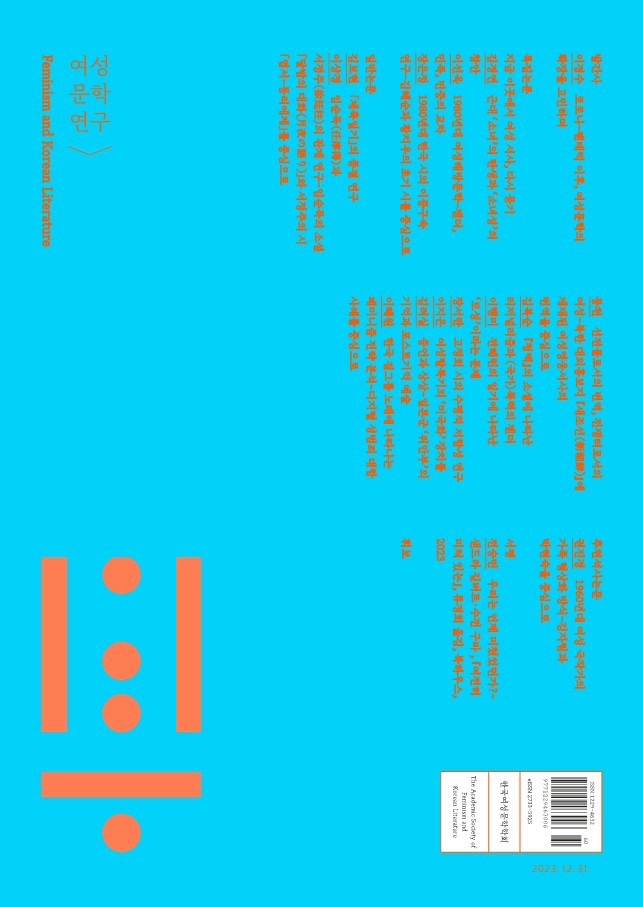- KOREAN
- P-ISSN1229-4632
- E-ISSN2733-5925
- KCI
 ISSN : 1229-4632
ISSN : 1229-4632
Article Contents
- 2024 (No.61)
- 2023 (No.58)
- 2022 (No.55)
- 2021 (No.52)
- 2020 (No.49)
- 2019 (No.46)
- 2018 (No.43)
- 2017 (No.40)
- 2016 (No.37)
- 2015 (No.34)
- 2014 (No.31)
- 2013 (No.29)
- 2012 (No.27)
- 2011 (No.25)
- 2010 (Vol.23)
- 2009 (Vol.21)
- 2008 (Vol.19)
- 2007 (No.17)
- 2006 (No.15)
- 2005 (No.13)
- 2004 (No.11)
- 2003 (No.9)
- 2002 (No.7)
- 2001 (No.5)
- 2000 (No.3)
- 1999 (No.1)
Emotions for Fight and Divisive Ego : Reproduced in the Family Novel Women/Hatred - <Sohyeonseongrok> around
Abstract
One's wife and concubine conflict appearing in the family novel is characterized by a strife which promote homosexuality reconciliation process, a number of women to occupy a grab males. 17th century is a period until the patriarchal system is still patriarchal system in order to have time on his way to ensure the maintenance could not be settled. Therefore ln <sohyeonseongrok> it made in this period resistance and men who want to build a patriarchal system, and this will generate a conflict between women who wish to pursue their own desires. However, women in this process if they desire and abandon the cause irony that only a desire to abandon the pursuit of his desire seems to be characterized by withdrawal hatred. In the process, women need to pursue and beautification with Saint Woman presenting characters are 'susinseo' for the role of social patriarchal system built by forced even the implied reader as well. Therefore, the reader reads the <sohyeonseongrok> is forced to agree with those implicit homosexuality reconciliation while achieving an orderly went to the patriarchal system is established. In this paper, we examine whether to pay attention to this aspect subjective Female Consciousness in sohyeonseongrok this the family novel, while combined with the genre look around the desire of women to be refracted through it implicitly forced homosexuality reconciliation is what is implemented.
- keywords
- 가문소설, 처처(처첩)갈등, 소현성록, 혐오, 미화, 강요, 여성 욕망, 가부장적 사회, 동성 간의 화목, The Family Novel, One's Wife and Concubine Conflict, Sohyeonseongrok, Hatred, Beautification, Coercion, Woman Desire, Patriarchal System, Homosexuality Reconciliation
Reference
정선희, 조혜란 역주, 『소현성록』, 소명출판, 2010, 1~6권.
이승복, 『고전소설과 가문의식』, 월인, 2000, 34~35쪽, 67~68쪽.
이영화, 『조선시대 조선 사람들』, 가람기획, 2003, 195쪽.
임치균b, 『조선조 대장편소설연구』, 태학사, 1996, 43~93쪽.
최일성․김현정 공저, 『한국 여성사』, 백산자료원, 2006, 132~141쪽.
기시다 슈, 박규태 역, 『성은 환상이다』, 이학사, 2007, 162~165쪽.
김석, 「정념, 욕망의 목소리 - 세 가지 정념을 중심으로」, 『철학연구』 45집, 고려대 철학연구소, 2012, 235~259쪽.
노정은, 『<소현성록>의 인물형상화변이 양상-이대본과 서울대 21권본을 중심으로』, 고려대 석사학위논문, 2004. 1~101쪽.
박영희, 『<소현성록>연작 연구』, 이화여대 박사학위논문, 1994. 1~258쪽.
백순철, 「<소현성록>의 여자들」, 『여성문학연구』 1, 한국여성문학학회, 1999, 127~154쪽.
서경희, 「<소현성록>의 석파 연구」, 『한국고전연구』 12, 한국고전연구학회, 2005, 69~100쪽.
양민정, 「<소현성록>에 나타난 여가장의 역할과 사회적 의미」, 『외국문화연구』 12, 한국외대 외국문학연구소, 2002, 101~126쪽.
이주영, 「<소현성록>인물형상의 변화와 의미-규장각 소장 21장본을 중심으로」, 『국어교육』 98, 한국국어교육연구회, 1998, 345~367쪽.
임치균a, 「<소현성록> 연구」, 『한국문화』 16, 서울대 한국문화연구소, 1995, 31~73쪽.
장시광a, 「소씨삼대록>의 여성반동인물 연구」, 『온지논총』 9, 온지학회, 2003, 107~148쪽.
장시광b, 「<소현성록> 연작의 여성수난담과 그 의미」, 『우리문학연구』 28, 우리문학회, 2009, 112~165쪽.
정길수, 『17세기 장편소설의 형성경로와 장편화 방법』, 서울대 박사학위논문, 2005, 1~264쪽.
정선희a, 「가부장제하 여성으로서의 삶과 좌절되는 행복-<소현성록>의 화부인을 중심으로」, 『동방학』 20, 동방학회, 2001, 57~84쪽.
정선희b, 「17세기 후반 국문장편소설의 딸 형상화와 의미 - <소현성록>연작을 중심으로」, 『배달말』 45, 경상대 배달말학회, 2009, 425~460쪽.
정선희c, 「<소현성록> 연작의 남성인물고찰」, 『한국고전연구』 12, 2005, 37~68쪽.
정창권, 「<소현성록>의 여성주의적 성격과 의의-장편 규방소설의 형성과 관련하여」, 『고소설연구』 4, 고소설학회, 1998. 293~327쪽.
조용호, 「삼대록 소설의 인물구성」, 『고소설 연구』 2, 한국고소설학회, 1996, 199~235쪽.
조혜란, 「소현성과 유교적 삶의 진정성」, 『고소설 연구』 36, 고소설학회, 2013, 167~200쪽.
최기숙, 「고소설의 감성 문법과 감정기호-<소현성록>의 감정 수사를 중심으로」, 『고소설연구』 39, 한국고소설학회, 2015, 103~139쪽.
